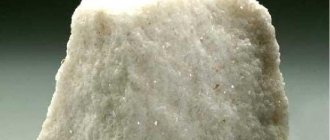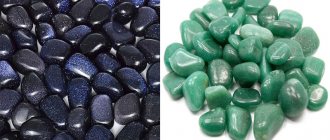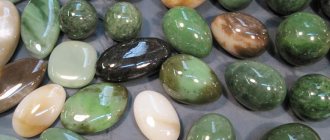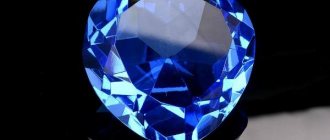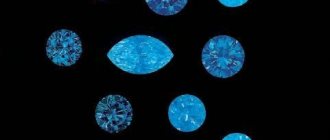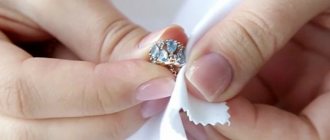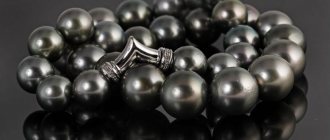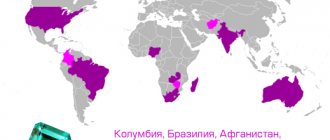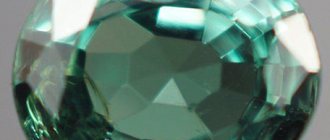Why are such gems valued?
Blue stone is chosen for many reasons:
- Jewelry with blue accents or stones of such shades indicates a developed aesthetic sense and taste of the owner.
- Blue color is a traditional attribute of wealth and power.
- It is preferred by those who clearly know what they need from life and how to achieve it.
- He embodies composure, calmness even to the point of tranquility.
Blue stones in jewelry never look tacky, vulgar or gloomy.
On a subconscious level, blue is associated with a cloudless daytime sky or the mysterious period of day preceding twilight.
ORINANCIAL BLUE STONES
The description of semi-precious blue stones divides them into 2 large groups:
- jewelry and semi-precious stones;
- actual semi-precious stones.
Jewelry and ornaments
Jewelry and ornamental stones - used both in the jewelry industry and for the manufacture of decorative items
Blue and blue-gray lapis lazuli
Lapis lazuli (obsolete name: lapis lazuli) is an opaque blue or gray-blue stone. The mineral is rarely homogeneous and contains inclusions of other rocks.
Blue lapis lazuli
Characteristics:
| Jewelry and ornamental, 1st order | |
| Hardness | 5,5 |
| Shine | glass |
| Refractive index | 1,50 |
| Transparency | opaque |
Peculiarities:
- dense lapis lazuli in dark blue, cornflower blue and violet colors is used in jewelry;
- standard form of processing - cabochon or plate;
- the most beautiful specimens of lapis lazuli contain golden inclusions of sulfur pyrites - once people mistook these veins for gold, so the blue stone had a high price;
- The best lapis lazuli is mined in Afghanistan, at the Sar-e-Sangv deposit.
Blue sodalite
Sodalite is a fairly rare mineral, sodium aluminum silicate. Colors range from spectacular blue to grayish blue. Frequent inclusions of foreign rocks.
Blue sodalite
Characteristics:
| Jewelry and ornamental, 1st order | |
| Hardness | 5,5–6 |
| Shine | glassy, greasy |
| Refractive index | 1.48–1.48 |
| Transparency | transparent, translucent |
Peculiarities:
- Deep blue sodalites are called “alomites” and are used by jewelers. The remaining varieties of the mineral serve as ornamental materials;
- in 2006, Stephen Webster and Theo Fennell named sodalite one of the most popular stones of the year, along with tanzanite, morganite and tourmaline.
Blue hawk eye
Hawk's (or falcon's) eye is a type of translucent quartz. It is distinguished by iridescence (the “cat’s eye” effect), which appears due to parallel hollow tubules and inclusions of the crocidolite mineral.
Blue hawk eye
The color of the mineral is dark blue, almost black with lighter bluish tints.
Characteristics:
| Jewelry and ornamental, 1st order | |
| Hardness | 4 |
| Shine | glass |
| Refractive index | 1.66 — 1.74 |
| Transparency | transparent, translucent |
Peculiarities:
- used to create large beads and cabochons - it is in this form that the iridescent effect is best manifested;
- Hawk's eye is less common than other varieties of iridescent quartz (cat's eye, bull's eye);
- the stone is practically not counterfeited, since it is extremely difficult to recreate the structure of its surface.
Blue agate
Agate is a variety of quartz that is easily recognized by its striped and concentric patterns.
Blue agate
Deep blue agates are rarely found in nature and are characterized by shades of blue-gray.
Characteristics:
| Jewelry and ornaments, II order | |
| Hardness | 6,5—7 |
| Shine | bold or matte |
| Refractive index | 1,57-1,58 |
| Transparency | translucent or opaque |
Peculiarities:
- homogeneous blue agates have their own trade term - sapphirine;
- Agates have pastel natural colors, so all stones of flashy colors have been pre-treated and will fade over time;
- Due to its strength, agate is used to make not only jewelry and decorative items, but also glassware for chemical laboratories.
We recommend: Review of BLACK STONES
Blue apatite
Apatite is the main component of apatite ores, forming crystals that are similar in appearance to the more valuable beryl and tourmaline. This is where the name of the mineral comes from, which is translated from ancient Greek as “I deceive.”
Blue apatite
Blue-green and blue apatites received their own name: moroxite (morochite), apatite spar or blue asparagus.
Characteristics:
| Jewelry and ornaments, II order | |
| Hardness | 5 |
| Shine | glassy to greasy |
| Refractive index | 1,59—1,66 |
| Transparency | transparent, translucent to opaque |
Peculiarities:
- due to its fragility and beauty, apatite is usually only of collection value;
- in rare cases, the stone is used in jewelry or for decorative purposes and requires careful handling;
- Common cutting methods are simple bevel or cabochon.
Blue azurite (copper glaze)
Azurite or copper azure is a derivative of copper ores. The mineral is known for its deep blue color, both pure and with a purple tint.
Blue azurite
Characteristic are striped and concentric patterns, as well as chaotic inclusions of other rocks.
Characteristics:
| Jewelry and ornaments, II order | |
| Hardness | 3,5–4 |
| Shine | glass |
| Refractive index | 1,72–1,84 |
| Transparency | translucent to opaque |
Peculiarities:
- azurite is fragile, but forms beautiful druses and is a collectible;
- in rare cases of use for jewelry and decorative purposes, the stone is polished cabochon or not cut at all.
Blue hemimorphite (calamine)
A common zinc silicate mineral that forms blue clusters of turquoise or mint crystals, similar to blue smithsonite.
Blue hemimorphite
Crystals often have light or white stripes and dark inclusions.
Characteristics:
| Jewelry and ornaments, II order | |
| Hardness | 4– 5 |
| Shine | glass |
| Refractive index | 1,61–1,63 |
| Transparency | transparent to opaque |
Peculiarities:
- well-formed crystals on a substrate become collectibles;
- in jewelry, colorless or deep blue crystals with high transparency or beautiful patterns are predominantly used;
- Some hemimorphite crystals glow in complete darkness.
Blue Larimar
Larimar is a rare milky blue silicate of volcanic origin. The mineral is characterized by patterns similar to reflections of light on water. The color palette ranges from mint to dark blue.
Blue Larimar
Characteristics:
| Jewelry and ornaments, II order | |
| Hardness | 5,5–6 |
| Shine | silky |
| Refractive index | 1.59–1.64 |
| Transparency | translucent, opaque |
Peculiarities:
- may become discolored after prolonged exposure to light;
- The main deposit of the stone is in the Dominican Republic. In other places larimar deposits are insignificant.
Actually-ornamental
Semi-precious stones are mainly used to create massive stone-cutting products.
Blue chrysocolla
Chrysocolla is a copper silicate, which colors the stone blue with a turquoise tint. The mineral is common and is mined in copper mines in the upper layers of veins.
Blue chrysocolla
Characteristics:
| Hardness | 2–4 |
| Shine | glassy, waxy, greasy |
| Refractive index | 1.57-1.63 |
| Transparency | opaque, sometimes slightly translucent |
Peculiarities:
- chrysocolla is known as Eilat stone, which is a veined mineral in light sandstone rocks;
- only durable forms of the mineral are used as a decorative material;
- processed only with large cabochons or flat inserts.
Blue fluorite
Fluorite or fluorspar is calcium fluoride that forms large crystals of blue or light blue color with purple or green tints.
Blue fluorite
Characteristics:
| Hardness | 4 |
| Shine | glass |
| Refractive index | 1,43—1,43 |
| Transparency | transparent or translucent |
Peculiarities:
- crystals are characterized by gradients and zoning of color - they appear as a result of defects in the crystal structure and the sensitivity of the mineral to changes in temperature and radiation levels;
- fluorite glows when heated and irradiated with ultraviolet light - the name “fluorescence” comes from the name of the mineral.
The names and characteristics of natural blue stones are much more varied than we used to think. Many of them are inserted into jewelry from famous jewelers, become museum exhibits and decorate items.
Related publications
- REVIEW OF PURPLE STONES
- Review of 13 PINK GEMS
- Such a different mineral CORUND
- RARE STONES - lucky to see them, lucky to have them
Assortment of minerals
The list of names of blue stones includes pure blue types and varieties of this shade in multi-colored minerals. There are types of blue stones, the shade of which is given by man.
Precious
According to the official jewelry classification, two stones are considered such.
Diamond
A diamond of these shades is the number one blue gemstone. Rarity of rarity: a pebble is found a year, and only in one place (South Africa). The price starts at $150 thousand per carat.
The Hope Diamond is a large diamond weighing 45.52 carats of deep sapphire blue color.
The most famous representative of the family is the legendary Hope Diamond . Its parameters are unique: 45.52 carats plus sapphire blue color depth. Plus an ominous aura: almost all of its owners died. The latter got rid of the stone almost 60 years ago, transferring it to the Museum of Natural History in the USA.
Sapphire
A blue variety of corundum. Viceroy of blue stones, one of the most beautiful in the segment.
The value is determined by the color. Cornflower blue, moderate intensity - a gemstone of the highest category, the most expensive. Too dark or too light specimens are several times cheaper. It is mined on almost all continents, but Sri Lanka produces the best jewelry raw materials.
Ring with Burmese sapphire
An attribute of the robes and headdresses of the highest hierarchs of the church and crowned heads.
Semi-precious
The most impressive and diverse segment:
- Aventurine. Standard shades are yellow-blue or reddish. The blue color of the mineral (like green) with sparkles is a rare exception. Blue aventurines are used only by jewelers.
Ring with blue aventurine - Aquamarine. A variety of beryl in blue shades: blue, cyan or blue-green mineral. The color depends on the amount of iron impurities. This is often the result of firing green or yellowish-green beryl.
Aquamarine pendant - Benitoite. A semi-precious stone that absorbs the energy of the Universe and transfers it to the owner. There are blue, violet, purple, light and dark blue stones.
Benitoite - Turquoise. Favorite stone of the East. The blue variety is the female version. A mandatory attribute of the wedding attire of Muslim brides. Brings positivity to life in all areas.
Turquoise - Jade. The standard color of the mineral is green. Blue specimens are rare, supplied only by Guatemala. Equated to precious. The variety of the mineral “Kingfisher jade” is distinguished by its bluish tint.
Beads with blue jadeite - Iolite A half or completely transparent mineral with a rich blue or violet color. The best natural imitation sapphire.
- Lapis lazuli. There are variations with colors ranging from violet-blue to greenish-blue and gray with a greenish tint. Most agglomerates are spotted or streaked. Lapis lazuli is supplied by Afghanistan, Russia, and the USA.
Ring with lapis lazuli and hairy quartz - Opal. Some varieties of this mineraloid have a blue tone or shades: jirasol is a transparent blue noble opal with the same opalescence; black – red-blue specimens of a dark purple or dark blue hue with bright red opalescence; Peruvian - opaque with a bluish-greenish pastel color. Jirasol and Peruvian opals are considered precious.
- Blue quartz. The second name is sapphire quartz. Quartz is one of the most common minerals used by jewelers and industrialists. But specimens of the blue variety are rare. This is a high-quality natural imitation of precious stones.
Blue quartz bracelet - Tanzanite. A blue variety of the mineral zoisite. A stone that changes color depending on impurities. There are blue (sapphire), blue-violet and purple-blue shades. High-quality processing makes tanzanite equal to first-level minerals. Production takes place in the only place on the planet - the African state of Tanzania.
Varieties of Tanzanite - Topaz London blue. London topaz is a variety obtained by irradiating pale blue topaz with neutrons to intensify the color. Scientists in London did this for the first time, creating a color reminiscent of the evening sky over Wales. Hence the name. The material is safe: the stones are kept in the laboratory until the radiation level decreases to normal values.
Pendant with London topaz – “Heart of the Ocean” - Tourmaline. Extraordinarily beautiful varieties of the mineral are blue elbaite and dark blue indigolite. Both are very fragile, so they cannot be inserted into rings or bracelets. They are processed in the likeness of a diamond, that is, brilliant cut.
Ring with blue Tourmaline - Zircon. The classic color of the mineral is straw-yellow; the blue variety is created by titanium impurities. It is rare and loved by jewelers. However, this is often the result of calcination of brown zircons.
- Spinel. Spinels of any color are rare and expensive, especially blue ones. Their coloring is multifaceted. There are dark, green, violet and black-blue versions of the mineral.
- Jasper. One of the most common gems. But blue or purple specimens are rare, which is why they are considered precious. A variety of jasper mixed with Prussian blue is called Swiss or German lapis. Used as an imitation of lapis lazuli.
Blue Jasper
High-quality semi-precious specimens are often comparable in price to precious stones.
Ornamental
The list of minerals is small:
- Onyx. In gemology, this is both a type of agate and an independent striped mineral. One of the banding options is blue and white. A rare blue variety is sapphirine. Used as an ornamental stone. It is used to make bracelets, beads, candelabra, and photo frames.
- Dumortierite. The mineral is mined in the USA, Europe (France, Czech Republic, Poland), and Madagascar. Brazil has transparent light blue samples. Used in the manufacture of premium quality porcelain, souvenirs, jewelry and as a collectible mineral.
Dumortierite crystal - Kyanite. The mineral is used as a raw material for industry (for example, for the production of refractories) and for decorative and ornamental purposes. Kyanites are simply blue, dark, green or violet blue. Jewelry is supplied by India, their ancient Russian name is bausy.
Kyanite bracelet - Azurite. Natural imitation of lapis lazuli. In jewelry, inserts are covered with silver mesh for safety. The “ancestor” of malachite, mined on all continents. Unusual specimens are sought after by collectors.
Ring with azurite
The mentioned stones are classified as ornamental because of their prevalence or low cost. Their aesthetic standards are worthy.
Artificial
This segment contains minerals of different qualities:
- Cubic zirconia, moissanite. High-tech products, high-quality imitation diamonds, recognizable only on special equipment. Structurally and externally they copy the original, which is often complemented in decorations.
Ring with cubic zirconia - Alpanit. An artificial mineral with a glassy texture and a full range of blue shades. Used for jewelry, imitating natural stones. Variant of the name is alpinite.
Alpanite earrings
The quality of alpanites is average, unlike cubic zirconias or moissanites.
Magic
The famous magical artifact of this color is located in Russia. This is the Blue Stone on Lake Pleshcheyevo, in Pereslavl-Zalessky (Yaroslavl region). A cult object of pre-Christian times.
The blue stone (Sin-kamen) is a sacred stone near Lake Pleshcheyevo.
In its normal state, gray turns blue when wet. A similar effect is created by the refraction of light by small grains of quartz and biotite flakes that make up the stone.
It is believed that the Blue Stone is capable of fulfilling a cherished wish, but only when it is wet and blue.
A B C D E F G H I J K L M N O P R S T U V
KAWAKAWA is the Polynesian (Maori) name for jade. CACORTOCITE is a feldspathoid syenite with numerous eulyalite inclusions. KALAZIAS (GELOZIA) – a magical stone of antiquity. Apparently, this was the name given to colorless corundum or diamond. KALAIT – turquoise. CALAMINA – hemimorphite. CALAMINA AZURRA – blue smithsonite, local name. KALAMIT – tremolite. KALBENITE is the local name for mirikit. CALYPTOLITE is an obsolete name for zircon. CALIFORNITE – dense aggregates of greenish, olive green and grass green vesuvianite. CALLAINITE is a turquoise-like material found in Celtic graves near Locmariaquer (France). CALLAINIT is a blue variety of highly translucent variscite. CALLAIS is the ancient name for turquoise. KALOTIN – coritis. KALTSENTIN is an imitation of opals from iridescent quartz-zoisite rocks. CALCIODIALOGITE – calcium rhodochrosite. CALCITE – anhydrous calcium carbonate. CAMELEONITE – chameleonite. STONE ROSE – desert rose, stone rose – intergrowths of gypsum crystals. STONE CROSS – a cross-shaped double of staurolite, painted blue. AVENTURINE STONE is a solar stone. ACOUSTIC STONE – the ancient name for carbuncles. ALEPPO STONE - eye agate from Syria, geographical name. ALIPUR STONE - ruby from the outskirts of Mysore (India). AMAZONIAN STONE – amazonite. AMARIL STONE - decorative, patterned chalcedony from Texas. AMULET STONE – coral. ARMENIAN STONE – lapis lazuli. ASPARAGUS STONE – yellow-green apatite crystals of regular shape from Spain. SATIN STONE is a fibrous type of gypsum. AZTEC STONE – dense masses of smithsonite. IMMORTALITY STONE - thin plates of jade (mostly jade), which were placed on the eyelids of the dead. According to Chinese tradition, this ensures immortality. BROWN BROWN STONE – hausmannite. BEZOAR STONE – bezoar. BELUGE STONE – bezoar. BRISTOL STONE is an ancient name for colorless topaz and quartz. BOTTLE STONE is a polysemantic term. Obsidian, moldavite or green tektites with facet cut. BUKHARA STONE – lapis lazuli. VENUS STONE – amethyst. VICTORIAN STONE - a glassy imitation of a gem with a fibrous structure and a cat's eye effect. Made in Japan by fusing quartz, calcite, fluorite, magnesite and feldspar. WATER STONE (WATER) – glassy orthoclase or opal hyalite. WAX STONE – agalmatolite. JET STONE – black tourmaline. GYPSUM STONE – colored varieties of gypsum. Ocellated STONE – thomsonite or ocellated agate, a polysemantic term. BLOCK STONE – jade or melanitis, a polysemantic term. BLUEBERRY STONE – peristerite. PEAS STONE – cemented oolites of aragonite. MUST STONE – agalmatolite. BURNING STONE – amber. GARNET STONE is an outdated name for garnet. DENDRITIC STONE - dendritic agate, chalcedony or opal, as well as petrified wood, a polysemantic term. DERBYSHIRE STONE - see Derbyshire spar, also a trade name for jewelry fluorite. DRAGON STONE – draconites. HEBREW STONE – written granite. JEWISH STONE – high quality Baltic amber, as well as Judaicus lapis. BISHOP'S STONE – amethyst. TOAD STONE – Botrax. PEARL STONE – perlite. SOUNDING STONE is the name of jade in ancient China. STONE OF HEALTH – pyrite. The name appeared in antiquity, when various medicinal properties were attributed to pyrite (Pliny the Elder). ZEBRA STONE – blue asbestos with crocidolite inclusions. GREEN STONE – jade or chlorastrolite, as well as prosiolite, a polysemantic term. GREEN STAR STONE – chlorastrolite. EARTH STONE is the ancient name for fossil amber. MIRROR STONE - gypsum, as well as talc, perhaps this is what specularis was called. SNAKE STONE – draconites. GOLDEN RED-BROWN SPAM STONE – aventurine with hematite inclusions. GOLDEN STONE – artificial glass, imitation aventurine. NEEDLE STONE – hairy. CAVIAR STONE – cemented aragonite oolites. IMORY STONE is a Victorian stone. IMPULSE STONE – moonstone. INDIAN STONE – touchstone. INCAN STONE – pyrite; see also Inca mirror. INCAS STONE – Inca stone. SPARKLING STONE – spinel. CAMBAYAN STONE – Indian carnelian. CANADIAN BLUE STONE – sodalite. CANARY STONE – yellow carnelian. KING STONE – glass imitation of jade. STONE OF WITCHCRAFT theotetl. QORAN STONE is a dark gray rock reminiscent of talc slate. BROWN STONE – hessonite or other garnet. CROSS STONE – twin crystals of staurolite, as well as andalusite (chiastolite). BLOODY STONE – hematite, as well as carnelian with bright red jasper ingrowths. GOOSEBERRY STONE – green grossular. CUBIC STONE – boracite. AZURE STONE – lapis lazuli. SWALLOWER STONE – chelidon. ICE STONE – cryolite. LIMORI STONE – glass imitation of jade. MOON STONE - potassium spar and plagioclase with a characteristic glow in the form of glittering white and bluish-white silver-blue stripes - the effect of adularization. MOON ADULAR STONE – orthoclase (adularia) with albite microinclusions, due to which a bluish-white or blue glow appears. ALBITE MOON STONE – albite with inclusions of potassium feldspar, mainly plagioclase. Thanks to these inclusions, a light blue glow appears. GREEN MOONSTONE – amazonite. CALIFORNIA MOONSTONE – white, translucent chalcedony, giving a bluish-white glow. CANADIAN MOON STONE – lead glass with an admixture of radioactive lead, as well as uranyl glass, giving the effect of moonstone. RED MOON STONE – opaque orthoclase containing albite crystals, has a faint glow. MADAGASCAR MOONSTONE – labradorite moonstone. MICROCLEAN MOON STONE – a highly translucent microcline containing albite. It has an internal glow - adulariscence. MOON STONE OLIGOCLASE – light blue and yellow crystals of oligoclase and albite, giving a white glow. OREGON MOONSTONE – blue-white chalcedony with an aventurescent effect. ORTHOCLASE MOON STONE – orthoclase with an admixture of albite, giving a white or bluish-white glow. PRISMATIC MOONSTONE – colored chalcedony with a silvery-white glow. PINK MOONSTONE – pink scapolite with white metallic reflections. BLACK MOONSTONE – microcline moonstone. RADIAANT STONE – actinolite. STONE OF LOVE – aventurine quartz. FROG STONE – toad stone. MADERIAN STONE – zircon. POPPY STONE – jasper with white or gray rounded inclusions in the red ground mass or vice versa. MAJORIAN STONE – New Zealand jade. HONEY STONE – honey-yellow chalcedony or mellite. MECC STONE – pink carnelian (carnelian). MILL STONE – pyrite. MILK STONE – galacite. FROST STONE - a diamond with white spots reminiscent of frosty patterns on glass, as well as frost agate. MOSS STONE – moss agate, dendritic agate. MOSSY STONE – moss agate. SOAPSTONE – (1) saponite mineral; (2) steatite – a type of talc; (3) colloquially and other stones that feel greasy to the touch. STONE OF HOPE – jade. OF HEAVEN – turquoise. STONE OF THE NILE - jasper mined in the upper reaches of the Nile. NEW ZEALAND GREEN STONE – jade. STONE OF NIGHT – synthetic rutile. SHAPED STONE – agalmatolite. FIRE STONE – opal. STONE EYE OF THE WORLD – hydrophane. DEER STONE – tugtupite. OOLITE STONE – aragonite. EAGLE STONE – aetite. ORCHID STONE – amethyst. PEACOCK STONE – malachite. Pagoda STONE – agalmatolite. PANAMU STONE is the Maori name for jade. Brocade STONE – jasper with numerous silver-golden specks. BROCADE STONE – brocade stone. LANDSCAPE STONE – landscape agate. PETOS STONE – marble. COCK STONE – alectorius. KIDNEY STONE – jade or jadeite, according to the Aztecs, was a good cure for kidney diseases. RAINBOW STONE – iris, as well as labradorite. RHINESTONE – rhinestone, the English name for rock crystal. PINK STONE – rhodonite, as well as rhodochrosite. PINK INCA STONE – rhodochrosite. LYNX STONE – yellow-brown or yellowish-red zircon. SARK STONE – amethyst from the island of Sark (Great Britain). SATIN STONE – satin stone. SUGAR STONE – datolite. STEPHAN'S STONE – white chalcedony with numerous red spots. SILVER STONE is the traditional name for moonstone in France. SINAI STONE – turquoise. BLUE STONE – sodalite or lapis lazuli, as well as chalcanthite. An ambiguous term. BLUE CANADIAN STONE – sodalite. RESINIC STONE – retinalite. RESIN STONE – obsidian. SUN STONE – plagioclase with the effect of aventurescence (feldspathic aventurine), and also the name of amber. ASPARAGUS STONE – light green Tyrolean apatite (Austria). GLASS STONE – axinite or hyalite. STEPHANOV STONE – heliotrope. SIERRA STONE – serra stone. TAUSIN STONE – labradorite or grayish sapphire. TIGER STONE – brown jasper with black or white stripes. TELEVISION STONE – thin polished ulexite plates. TIBETAN STONE - a mixture of aventurine quartz and eosite, as well as porphyrite. AX STONE – jade. PIPE STONE is a type of jasper. TURKISH STONE – turquoise. FIGURED STONE – agalmatolite. PURPLE STONE – cordierite. STONE OF FREDERICK THE GREAT – chrysoprase. CHAMELEON STONE – hydrophane. CINNAM STONE – hessonite. GARLIC STONE – scorodite. WONDERFUL STONE – pyrophyllite. SCOTTISH STONE – smoky quartz (rauchtopaz). SPRUDELSTEIN STONE is an aragonite formed in hot springs. OKHOTSK STONES – marekanite. CANARY TOURMALINE - see CANARY TOURMALINE. KANASITE is a mineral of the silicate group. CANDITE – blue spinel. CANCRINITE is a mineral, aluminosilicate with a frame structure. Varieties: cherry and microsommite. CANUTILLO - high quality emeralds from Colombia. CAP EMERALD is a prehnite from South Africa. CAP RUBIN – pyrope. CAP-CHRYSOLITE - prehnite from South Africa. KAPNIKIT is the old name for rhodonite. CAPNICITIS is the old name for wavellitis. CAPRA JAM is a synthetic rutile. CAPRI – synthetic rutile. CARBONADO is a gray-black and black microcrystalline variety of diamond. CARBONETTO is a purple variety of calcareous red coral. CARBUNCLE is an old name, used for many centuries, for mainly red stones: garnets, rubies, spinels and topazes. CARINTHIT is a type of wulfenite. CARNATITE - labradorite, an outdated term. CARNELIAN is a red and orange variety of chalcedony. CARNEOL is a translucent variety of chalcedony (carnelian) of pink or light red color, turning into dark brown. CARNEOL YELLOW – yellow chalcedony. CARNEOL-ONYX - ribbon agate with alternating red-brown and white layers. KARUBA is the old Persian name for amber. KARFUNKEL is an old trade name for pyropes, rubies and spinels, as well as other bright red stones, a polysemantic term. CARCEDONIUS is the ancient name for green stones, primarily grossular, uvarovite and jasper (Pliny, Agricola). CASSINITE is an orthoclase containing a significant amount of barium feldspar. CASSITERITE is a mineral, tin oxide, isostructural modification of rutile. CASTORITE – petalite. CATALIN is an imitation of ornamental stones made from phenolic resins. CATALINAITE - jasper from Cape Catalina (Guam Island). KATANGITE is a variety of chrysocolla. CATAPLEITE is a mineral, zirconium-sodium silicate. KATEL is a very lightly colored beryl. CATLINITE is a kaolin-like mineral used in the form of jewelry by the Indians. CAHOLONG is a translucent, porous opal with a pearlescent sheen of white or bluish-gray color, as well as an opaque or slightly translucent milky-white agate. KAHURANGITE is a light green translucent jade from New Zealand. KATSABR is the ancient Arabic name for jet. CASHALONG is an old name for porous opal. KASHAN-RUBY – synthetic ruby. KASHGAR-JAD – low quality jadeite. KASHMIR BLUE – cornflower blue sapphire. QUARTZ is a mineral, one of three polymorphic varieties of silicon dioxide. AVANTURINE QUARTZ – aventurine. AZURITE QUARTZ is a granular variety of blue quartz, which is given to it by randomly located intergrowths of crocidolite and dumortierite. AMETHYST QUARTZ – amethyst. ARTICHOKE QUARTZ is a morphological variety of rock crystal. COLORLESS QUARTZ – rock crystal. BABYLONIAN QUARTZ is a morphological variety of rock crystal with a stepped crystal shape. VARISCITE QUARTZ – quartz “overgrown” with variscite. HAIRY QUARTZ - a type of quartz with numerous hair-like ingrowths, see rutile, acicular quartz. HAIRY QUARTZ – hairy. HAIRY QUARTZ – hairy. BLUE QUARTZ is a pale blue to pale violet-blue variety of quartz. The color is given by ingrowths of rutile, tourmaline and magnetite. SMOKY QUARTZ – rauchtopaz. YELLOW QUARTZ – citrine. VENINED QUARTZ – ordinary quartz with a parallel-veined structure. FAT QUARTZ – ordinary quartz, characterized by a greasy sheen. NEEDLE QUARTZ - a type of quartz (usually rock crystal) with numerous needles or hairs of inclusions of rutile, asbestos, actinolite, goethite, etc. EMERALD QUARTZ - prase. IRISHING QUARTZ – rainbow quartz. RED QUARTZ – flint with a high iron content. QUARTZ – azurite quartz. MILKY QUARTZ – a type of quartz with a milky color. NILE QUARTZ – gray-brown or brown spherical jasper. PRISMATIC QUARTZ – cordierite. RAINBOW QUARTZ – pure colorless quartz with numerous microcracks and iridescence. PINK QUARTZ – ordinary pink quartz. RUTILE QUARTZ – quartz with inclusions of hair-like red and golden-yellow rutile ingrowths. SAPPHIRE QUARTZ – quartz with inclusions of blue asbestos fibers. TOPAZ QUARTZ – smoky quartz (rauchtopaz). CRYSTAL QUARTZ – rock crystal. SCOTTISH QUARTZ – smoky quartz (rauchtopaz). QUARTZITE is a metamorphic rock consisting of quartz. SHOKSHINSKY QUARTZITE is a homogeneous reddish, dark brown quartzite mined in Karelia on the southwestern shore of Lake Onega. BELORETSKY QUARTZITE – speaks white. KVIRITA is a magical stone of antiquity and the Middle Ages. Mineralogical identification is not possible. KEYSTONEITE is a blue chalcedony colored with chrysocola inclusions. KERAVNIUM - in ancient times was considered a magical stone. Mineralogical identification is not possible. CERAMITE – scapolite. CERULEOLACTITE is a solid solution, the extreme members of which are planite, variscite and wavellite. KERCHENITE is a finely dispersed product of alteration of vivianite. KYANITE is kyanite, a mineral, most often blue in color, from the group of island silicates. KIANOS is the ancient name for blue stones: kyanite, azurite, lapis lazuli, etc. KIMBERLITE is an igneous rock enriched in olivine. KIMZEIT is a dark brown zirconium garnet. CINBOAR – mineral, mercury sulfide. KYPRINE is an opaque variety of vesuvian, light blue and blue-blue in color. KIRIS is the old Mongolian name for turquoise. BRICK ORE – a mixture of cuprite and limonite. KLAPROTIN is an old name for lasulite. KLAR is a type of amber. CLEVELANDITE is a type of albite. CLEIOPHANES – sphalerite without iron admixture, forms transparent crystals of light yellow, honey or greenish-yellow color. CLINOHUMITE is a mineral, a monoclinic variety of humite. CLINOZOISITE is a mineral of the epidote series, isomorphic to epidote and piemontite. CLINOCHLORE is a mineral of the chlorite group, also known as seraphinite. KNORRINGITE is a green chromium garnet. KNOCH – white opaque amber. COBALTINE is a mineral, sulfide of arsenic and cobalt. COBALT FLOWERS – erythrin. COVELLINE is a mineral of the composition CuS (divalent copper sulfide), an extreme member in the Cu-S solid solution system. ENGLISH LEATHER – pink and pink-red coral. KOKINERITE is a type of chalcocite with an admixture of silver. COLLOCHROM is a synonym for crocoite. COLOPHONITE is a cloudy variety of opalescent yellow-brown andradite. COLUMBITE is a mineral of the oxide group, isomorphic with tantalite. COMBED PYRUM – marcasite in the form of jagged doubles, reminiscent of a cockscomb. IRON PURITY – pyrite. SPEAR-SHAPED PYRUM – marcasite of the appropriate shape. PYRITY VIOLATE – pyrite. MAGNETIC pyrite – pyrrhotite. COPPER PYRITY is an outdated name for chalcopyrite. MOLYBDENUM PYrite – molybdenite. ARSENIC PYRITY is an outdated name for arsenopyrite. TIN PYRITY is an outdated name for stannin. SULFUR PYrite – pyrite. KONAMARA – noble translucent serpentine. CONCHITE is a fibrous or lamellar variety of aragonite, the main component (along with chitin) of pearls and the nacreous layer of mollusk shells. COPALINE is an amber-like fossil resin. COPILLITITE is a zinc-iron variety of rhodochrosite. Coral - skeletons of marine invertebrates (polyps) consisting of calcite and aragonite. Coral Tosa is a white Japanese coral. Coral Horn is black coral. Japanese coral -lime coral dark red with a white axial part. Koralin is a halzedon, artificially painted red. Cordorite - dichrote, ioit, stone of lynxia. Coreitis is agalmatol. Corneolus is the name of Carneol in the Middle Ages. Kornerupin is a mineral of a class of borosilicates. Cornitite - mineral, anhydrous phosphate copper with hydroxilic CU3 (PO4) (OH) 3. A rare secondary mineral of oxidation zones of some hydrothermal copper deposits. Coronitis is light brown Dravite. Corsican greens - Bastitite with the effect of Schiller. Korund - mineral, aluminum oxide. Transparent varieties: ruby and sapphire. Zvozdnaya corundum - Asterix. Blue Corundum - sapphire. Corundry Chergery - Hyacinth -colored corundum. Corunditis is a white synthetic spinel. Catterite is a quartz with a characteristic pearl shine. Cat's eye - inilizes; In a broad sense - any mineral with the optical effect of a cat's eye in the form of a light strip, resembling a pupil of a cat and moving along the surface of the mineral into the opposite inclination side. Hungarian cat's eye is the trade name of the quartz. East cat's eye is a cereal -berilla cat's eye, as well as a sapphire with a cat's effect. The cat's eye is western - the trade name of the rock crystal. The cat's eye is ruby - Rubin with the inclusion of needles Rulal, which has the effect of a cat's eye. Cat eye topaz - the commercial name of the yellow topaz. The cat's eye is tourmaline - a tourmaline with the effect of a cat's eye. The cat's eye of chrysoberillus is Tsimofan, the merchant name of the chrysoberill with overflow. The cat's eye is Ceylon - the trade name of Tsimophan. Cat Gold - Pit. CRAMERIT -light brown sphalaris. Kranberry - Rubellite. Red copper ore - kuprite. Red light silver ore is an obsolete name for twig. Red zinc ore - zincite. Red tree is mountainous - obsidian with black and red stripes. Red iron iron ocher - hematite. Flint is an aggregate of hide -to -to -hectal and amorphous silica. Creolin -Brectia jasper and red-white ribbon jasper. Creed is a mineral of a grade class. Cryolite is a mineral of a grade class. Chrispit - quartz and agate with green hair -like (needle) inclusions. Crystallus - in antiquity, mountain crystal, as well as pure calcite crystals. Christoballitis is a high -temperature polymorphic variety of quartz. Chrisellektrum is an ornamental and magic stone of antiquity. Perhaps this is amber, yellow quartz, pyrite, marcasitis or chrysoberill. Blood -hematite, as well as brown or red-brown carneol. Crocidolite is a morphological variety of asbestos. Crocette is a mineral, class classes. Komolite is a transparent dark green turmaline. Cruisis is a variety of chiastolithic. Xantitis is a translucent yellow-brown variety of Vesuvian. Xantoconite is a variety of twigs. Xantolite is a variety of stavrolite, as well as the wrong name of Andradit, strongly contaminated with impurities. Xilopal - Hubble wood, in composition of opal. Xylotil is a hungry fossil tree. Kilkhutl is the Aztec name turquoise. Kubait - Mount Crystal from Cuba, the local name. Another meaning is the pseudocubic crystals of quartz of the rhomboedric gabitus. (Do not confuse Kuban and Kubit). Kubanite (quanite) - mineral, copper and iron sulfide Cufe2S3. Cuboite (Cuboite) - Analcim. Kuncite is a jewelry variety of spodumen. Baselskaya font - unsocused cross -shaped doubles of Stavrolite. Used as amulets and as church and cults. Domebruste Kolchens - Pyat. Kuprite - mineral, copper oxide. Kuprobamin is a copper -containing adamin. Kuprosamit is a copper -containing adamin. Kournokovit is a group of hydrated braters. Kyauke-Ate -Zhadeite. Kand - fluorite mined in the UK (Cornwall). The traditional local name. Kyustelit is a type of native silver with a gold content of 10-30%, an intermediate member of a number of gold-serebly.
Magic properties
Astrologers say that blue stones are most suitable for representatives of the Air and Water elements.
But minerals are useful for everyone in the following situations:
- The need to recover from shock or other mental shock.
- Attract inspiration, interrupt a crisis, stagnation in thoughts (for creative people).
- Neutralize chronic dissatisfaction with life.
- The desire to open the “third eye”, other paranormal abilities.
Esotericists say that any natural blue stones are suitable for magic: jewelry value does not affect the magical sphere.
Therefore, you can choose an option based on your personal financial capabilities.
Therapeutic effect
Therapeutic “specialization” of minerals of the celestial range:
- neutralization of emotional stress, depression or aggressiveness;
- ensuring healthy, sound sleep;
- help with heart ailments, hypertension, asthma;
- normalization of metabolism, gastrointestinal tract function;
- treatment of skin pathologies.
The main mission of blue stones, according to psychologists, is to radiate calm, to tune a person into a philosophical attitude towards the vicissitudes of life. This is a talisman against phobias and nightmares.
As a result of the peace of mind given by blue stones, the immune system is strengthened.
It is advisable that when worn, the stones in jewelry come into contact with the body.
Why do you dream about blue stones?
Dream books associate shades of blue with high matters: spirituality, intuition, subconscious desire for the heavenly light.
General interpretation
According to Miller’s dream book, if you dreamed of blue stones, a white stripe will dominate your life:
- The situation will improve in all areas: personal life, business, health, making dreams come true. Especially if you dreamed that pebbles were given to a sleeping person.
- If in a dream the stones did not cause delight or other similar manifestations, you will soon have to choose from a list of possibilities.
If jewelry provokes panic, confusion, plans and hopes are not realized.
Type of stone
It’s wonderful when you were able to recognize the type of pebble you dreamed about:
- aquamarine - you are on the verge of successful endeavors or meetings with a soul mate;
- turquoise - the search for love will be successful, and love itself will be dizzying;
- sapphire – unexpected profit or spiritual “dividends”;
- topaz - a magician or witch lies dormant in you, you should study the secret sciences.
Sky blue star sapphire
In any case, a good sign is that the dreamed stones are solid, shiny, without cracks, chips, or cloudiness.
Decorations
If it is not possible to recognize a pebble, the type of jewelry matters:
- Ring. Passionate, mutual love will surge, the finale of which will be marriage. Perhaps this will be an old acquaintance whom you will appreciate in a new way. For a family man, a ring with a blue stone means a common project with his other half. If the ring is antique, there will be quick communication with future destiny. However, this love most likely will not be cloudless.
- A signet ring promises ease of communication with the opposite sex or a quick meeting with an old acquaintance who will become a friend.
If you found a ring in a butchered bird or fish in a dream, expect profit or good news from afar.
- Earrings. Receiving good news or implementing a personal business project. Especially if they are gold earrings. If they were given to a person, the problems are over, you can serenely enjoy life.
Lost an earring in a dream - there will be troubles in reality.
- Stones in a pendant foreshadow large expenses. If you buy it yourself, be smart about your purchases. But a pendant or pendant as a gift foreshadows the imminent realization of a dream.
Beads mean a series of pleasures, a brooch means an increase in life status.
BLUE PRECIOUS STONES
For a blue stone to be classified as precious, it must have high parameters of strength, purity and reflect light well.
Blue Diamond
A diamond is a diamond that has been cut into a shape that fully reveals the light-reflective characteristics of the mineral.
Blue diamonds are extremely rare and are highly prized by jewelers.
Blue Diamond
Characteristics:
| Precious, 1st order | |
| Hardness | 10 |
| Shine | diamond |
| Refractive index | 1,69–1,70 |
| Transparency | transparent |
Peculiarities:
- no more than 1-2 blue diamonds are found per year, so most blue diamonds sold are synthetic;
- blue crystals can have shades of purple, gray or green;
- Blue diamonds are even rarer. One of them, the Hope Diamond, has a sapphire hue and now belongs to the Smithsonian Institution in Washington.
Blue sapphire
Despite the fact that in nature the stone is found in all colors of the rainbow, mineralogy calls the blue gem a classic sapphire.
Blue sapphire
Characteristics:
| Precious, 1st order | |
| Hardness | 9 |
| Shine | glass |
| Refractive index | 1,76–1,77 |
| Transparency | transparent |
Peculiarities:
- the most valuable are bright blue stones with a cornflower blue tint;
- often blue crystals have a gradient of green and yellow;
- “star sapphires” - crystals with an asterism effect - are highly valued. Such stones are cut in the form of cabochons, and the star on their surface should be symmetrical;
- Synthetic stones occupy a large share of the market. Outwardly, they do not differ from natural ones, but are half the price. The origin of the crystal can be clarified in its passport.
Sapphire blue indigolite
Indigolite is a rare variety of blue tourmaline. Its crystals have a deep blue color, often with shades of sea green.
Sapphire blue indigolite
Characteristics:
| Precious, II order | |
| Hardness | 7–7,5 |
| Shine | glass bold |
| Refractive index | 1,61–1,65 |
| Transparency | transparent |
Peculiarities:
- Due to its dark color, indigolite is usually faceted in the form of flat crystals;
- The most valuable are specimens with the effect of pleochroism - depending on the angle of illumination, their color changes from dark to light.
Blue Topaz
A representative of aluminum silicates, topaz, often forms not very valuable colorless crystals.
Blue Topaz
Titanium impurities in the soil give topaz a delicate blue color, and such stones are highly prized by jewelers.
Characteristics:
| Precious, III order | |
| Hardness | 8 |
| Shine | glass |
| Refractive index | 1,60–1,63 |
| Transparency | transparent |
Peculiarities:
- among blue topaz there are crystals with a gradient from blue to yellow - such specimens are the most expensive;
- one of the largest deposits of blue topaz is located in the Ilmen Mineralogical Reserve in Russia in the Urals;
- blue topazes gradually fade under bright sunlight.
Blue-blue spinel
Only “noble” spinel - transparent crystals with a rich color - is classified as precious stones.
- Blue spinel sapphire - crystals colored deep blue, sometimes with a greenish tint;
- alexandrite spinel - under artificial light changes color from blue to purple-violet;
- blue spinel - bright blue crystals.
Blue-blue spinel
Characteristics:
| Precious, III order | |
| Hardness | 7,5–8 |
| Shine | glass |
| Refractive index | 1,71–1,76 |
| Transparency | transparent, translucent |
Peculiarities:
- Blue spinel is a rare mineral and natural stones are rarely found in jewelry. Most often, buyers are offered synthetic crystals;
- deposits of blue and cyan spinel have been found in Myanmar, Sri Lanka, Brazil, and the Russian Baikal region.
We recommend: TOP 16 scarlet gems
Blue aquamarine
Aquamarine is another variety of beryl. It is characterized by blue colors, both pure and with green or gray shades.
Blue aquamarine
Characteristics:
| Precious, III order | |
| Hardness | 7,5–8 |
| Shine | glass |
| Refractive index | 1,57–1,58 |
| Transparency | transparent |
Peculiarities:
- individual stones have a distinct pleochroism effect - when the lighting changes, the color changes from pale blue to sky blue;
- When heated, the color of aquamarine becomes more saturated. Therefore, some suppliers pre-heat-treat the crystals to improve their performance;
- Only stones of high purity are classified as precious. But semi-precious aquamarines, instead of transparency, have other interesting properties - such stones have asterism and the “cat’s eye” effect, inclusions in the form of snowflakes and stars.
Moon rock
Moonstone (adularia) is a rare type of feldspar, the iridescence of which is similar to moonlight.
Moon rock
Adularia is a milky white and gray crystal with a blue pearlescent tint.
Characteristics:
| Precious, III order | |
| Hardness | 6–6,5 |
| Shine | glass |
| Refractive index | 1,52 |
| Transparency | translucent, |
Peculiarities:
- some specimens have a “cat’s eye” effect;
- crystals are polished into cabochons or plates;
- Varieties of moonstone are labradorite and belomorite.
Deep blue machiche beryl
Beryl includes several varieties of precious stones. Among them, the blue mineral beryl machiche stands out.
Deep blue machiche beryl
Characteristics:
| Precious, IV order | |
| Hardness | 7,5–8 |
| Shine | glass |
| Refractive index | 1,56–1,60 |
| Transparency | transparent |
Peculiarities:
- the mineral was named after its place of extraction in Machis, Piaui, Brazil;
- the only and significant drawback of a dark blue stone is that it very quickly loses color in sunlight;
- Augustite beryls are more valued; they have similar external and physical parameters to machiche, but discolor more slowly.
Blue and blue-violet tanzanite
Tanzanite is a rare blue mineral, one of the varieties of cyosite. Externally, blue tanzanite crystals are very similar to sapphire, but are slightly inferior in strength and brilliance.
Blue tanzanite
Characteristics:
| Precious, IV order | |
| Hardness | 6,5–7 |
| Shine | glass |
| Refractive index | 1,69–1,70 |
| Transparency | transparent, translucent |
Peculiarities:
- tanzanite became famous thanks to the jewelry company Tiffany and Elizabeth Taylor, who wore jewelry with the stone;
- in jewelry, ultramarine or sapphire blue shades are valued;
- The blue color of stones can be either natural or obtained artificially after heat treatment of yellow-brown tanzanites;
- tanzanites are often replaced with glass fakes, synthetic spinels or sapphires;
- the only deposit of the mineral is in Tanzania.
Blue-blue benitoite
Benitoite is rare in nature and is a silicate of barium and titanium. It is similar in appearance to sapphire and forms small blue or cyan crystals.
Blue-blue benitoite
Characteristics:
| Precious, IV order | |
| Hardness | 6 — 6,5 |
| Shine | glass |
| Refractive index | 1,75–1,80 |
| Transparency | transparent |
Peculiarities:
- highly valued by jewelers as a rare stone with good physical properties;
- the processed crystals are characterized by the effect of pleochroism;
- the only regular deposit is in California;
- the largest benitoite (7.83 carats) is exhibited at the Smithsonian Institution in Washington.
Blue kyanite
Kyanite (or kyanite) is an aluminum silicate and forms crystals in a variety of colors.
Blue kyanite
Blue kyanites are the most common. They form both pure crystals without impurities and compounds with accompanying rocks, looking like gray veins. The stones come in blue and sapphire blue shades.
Characteristics:
| Precious, IV order | |
| Hardness | 4,4-7 |
| Shine | Glass (pearl) |
| Refractive index | 1,72 |
| Transparency | transparent, translucent |
Peculiarities:
- Kyanites are characterized by pleochroism: from blue to light blue;
- some stones have a “cat’s eye” effect - cabochon cuts are used for them;
- Kyanite hardness varies in directions: transverse - 7, longitudinal - 4.4. Hence the second name of the mineral “disthene”, which is translated from the Greek “double strength” (“dis sthenos”).
We recommend: Green gems: TOP-18
Blue zircon
Zircon is a silicate characterized by warm shades: brown, red, green or gray. Zircon obtains its blue and blue colors artificially by calcination.
Blue zircon
Characteristics:
| Precious, IV order | |
| Hardness | 7,5 |
| Shine | diamond |
| Refractive index | 1,77–1,98 |
| Transparency | transparent |
Peculiarities:
- after heat treatment of red-brown zircon crystals, they acquire a bright blue color - this type of stone is called “starlite”;
- Unfortunately, artificially obtained coloring may fade over time.
Blue cordierite (iolite)
Cordierite (obsolete name: iolite) is a magnesium and iron aluminosilicate that forms crystals of various shades of blue. The stones may have speckled inclusions.
Blue cordierite
Characteristics:
| Precious, IV order | |
| Hardness | 7–7,5 |
| Shine | fatty |
| Refractive index | 1,53–1,55 |
| Transparency | transparent, translucent |
Peculiarities:
- the crystals are distinguished by strong pleochroism - from pale blue to dark blue-violet and yellow;
- a valuable collectible mineral, transparent specimens are used in the jewelry industry;
- The stone accepts any treatment well, but when cutting, the direction of pleochroism must be taken into account.
